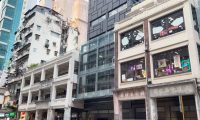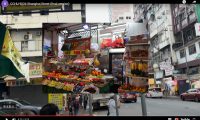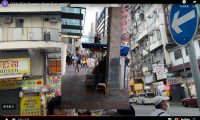5 stills from the video (took from field trip)
Hong Kong has long been crowned an international financial centre. Lofty skyscrapers, intertwining highways and underground railways has long been part of the image that Hong Kong has held since the start of the 21st century. Nonetheless, with the resurgence in popularity of neo-noir Hong Kong films like Chungking Express, the depictions of Hong Kong on social media has seemingly shifted towards its parts that are fading away. A visit to Sheung Hai Street attempts at unveiling the vanishing fragments of the city —
Tong Lau is a Southern Chinese style shophouse popularized in Hong Kong since the 19the century. Its major features are its long and narrow outer complex, pillars supporting the residential shelter over the ground-floor shop, and narrow and dark stairways. The development of this architectural style could be explained by daily economic activities carried out in old city centres, where families own small traditional businesses directly under their homes during English-owned Hong Kong.
Let’s take a look inside the interior of Tong Laus through the movie Little Cheung (1999). (Transition) The movie navigates through Hong Kong on the cusp of handover. In crowded apartments and narrow alleyways lived families that all had a close relationship with each other; with neighboring adults looking after children next door all the time, elderlies huddled together at the counter of a local shop, and schoolchildren hypnotized by the recently introduced television in Cha Chaan Tengs. Although the living environment might be limited and sometimes unhygienic, the wooden stairs and furniture in the flats and its outer complicated pipe systems amplifies the closeness of its tenements by filling the scene until physically leaving no space in between them, portraying their relationship in a literal way. Another demonstration with the same method would be the prominence of mixed land use, for instance, local schools being located right next to, or sometimes even inside Tong Laus.
(Transition) From the movie we can see that the social significance of Tong Laus are not to be overlooked. Thus, our visit to Sheung Hai Street endeavors various traditional occupations that were essential to the neighbourhood decades ago. Fruit markets, herbal tea stores, bakeries, hardware stores, pawn shops; even the Yau Ma Tei Jade Hawker Bazaar, are all still seemingly in operation with elderly regulars chatting with the shopowners joyfully. Yet, a few minutes’ walk away from these shops lies Nathan Street, where numerous chain stores and multinational companies are bustling with customers of different ages. The signature neon signs hung on Tong Laus are no feat of advertising campaigns proposed by these companies — the mode of advertisement has long passed the need for emotional connection between the customer and the shop owner, but rather has become dependent on maximizing the exposure of a brand identity through online resources and discount events. With supermarkets and convenience stores has slowly overtaking the market in the age of the 21st century, there is no doubt that local stores are slowly chipping away from Hong Kong’s streets and alleys.
The main purpose of Tong Laus has certainly been eradicated following this development. Relying on neighborhood regulars to sustain their business, many business owners kept their retail shops running; however, many has long moved from the apartments above into public housing provided by the government. Before the 1960s, multiple tenants used to live in one Tong Lau, sharing the cockloft as a kitchen or working area. However, ever since the 1960s, many of the Tong Laus were knocked down as the demand for high-rise buildings have risen. Indigenous residents were compensated with either financial benefits or apartments, however many communities have ceased to exist. Most remaining Tong Laus nowadays are no longer residential but wholly used for economic purposes; higher floors are inevitably left idle even though traces of people living in it were left behind – pipe systems, antennas and clothing racks are still visible in the outer walls of shorter Tong Laus until this day.
As an effort to preserve the traditional and unique architectural style of Tong Laus, the government launched the Kowloon Tong Lau project in 2019. Tong Laus were revitalized into shopping malls and restaurants to generate profit under the success of tourism in Hong Kong. 618 area, situated on Shang Hai Street near Langham Palace, was revitalized into a mall that contains shops selling fashion items, souvenirs and traditional essentials such as carved wooden plates and pieces of china. The walls of these revitalized are all painted with Chinese style watercolor painting along with decorations such as flowers and market activities. Traditional folding screens and bird cages could also be found as an attempt to showcase the aesthetics of Old Hong Kong.
(Transition) Yet, the venture into heritage preservation is not an easy path.
One of the greatest difficulties in preserving pre-war Tong Laus is that only a small portion of them are officially registered as cultural heritage or historical buildings. With 60% of Tong Laus registered and in idle, it is difficult for the government to list these Tong Laus with unknown ownership into historical buildings. In other words, even if revitalization work could be successfully carried out with the current scheme, the government still could not assure that all remaining Tong Laus to be revitalized and fully protected as they are not part of the list of official historical buildings. Thus, these Tong Laus would only face the same fate as their precedents – they would be pulled down when their states become worn out enough to impose danger to pedestrians; in 10 years’ time, the only Tong Laus that might remain would be the very few “signature” ones that survived luckily.
Another hindrance to the preserving of Tong Laus would be its ownership issues. Owners of Tong Laus usually refuse to revitalize or renovate the buildings, as immense cost, skill and labour would be required. For Tong Lau owners to choose to keep their own buildings as an asset instead of selling the piece of land to others, more economic incentive for this development should be launched compared to the mere amount that the current Integrated Building Rehabilitation Assistance Scheme offers. It is also onerous for the government to balance the ownership and the potential of the building, such that thoughts of withdrawing private-owned housing for revitalization are out of the equation.
So is the local culture of Hong Kong still really be preserved? Are intangible cultural heritages of Hong Kong still present, even with the gradual fading of local communities and traditional occupations? Does the performative nature of revitalization really preserve the essence of a building, even if its interior is entirely redesigned and renovated? What will the future of Tong Laus be? These are the questions that a fast-changing city like Hong Kong are currently facing, and hopefully, not only these questions, but also the distinctive cultural identity of Hong Kong, would remain 10 years later.
-Chan Chun Pong 3036267135 , Chan Sui Tsit 3036237465




